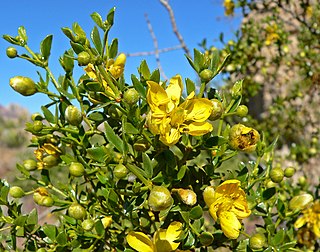
In the botanical classification of plants, Aeridinae Pfitzer is a subtribe of the tribe Vandeae whose representatives all have a monopodial growth habit and do not possess pseudobulbs.

Zygophyllaceae is a family of flowering plants that contains the bean-caper and caltrop. The family includes around 285 species in 22 genera.

Echeveria is a large genus of flowering plants in the family Crassulaceae, native to semi-desert areas of Central America, Mexico and northwestern South America.

The genus of the myrrhs, Commiphora, is the most species-rich genus of flowering plants in the frankincense and myrrh family, Burseraceae. The genus contains approximately 190 species of shrubs and trees, which are distributed throughout the (sub-) tropical regions of Africa, the western Indian Ocean islands, the Arabian Peninsula, India, and South America. The genus is drought-tolerant and common throughout the xerophytic scrub, seasonally dry tropical forests, and woodlands of these regions.

Haloragaceae is a eudicot flowering plant family in the order Saxifragales, based on the phylogenetic APG system. In the Cronquist system, it was included in the order Haloragales.

Oxossia is a genus of flowering plants in the subfamily Turneroideae (Passifloraceae) consisting of 15 species. This genus was recently defined in 2019 after a phylogenetic analysis of Turnera justified the creation of the genus. The genus is characterized by its stipules, small flowers, congested inflorescences, "hairy" stamen and style, and the attachment of stamen to the floral tube. All members of the genus are heterostylous with the exception of O. dasystyla. The genus can be divided into two morphological groups: those with white petals and those with yellow pink or red petals.
Oxossia albicans is a subshrub in the genus Oxossia. It is native to the wet tropics of eastern Brazil, specifically the Atlantic forest. It is 40 - 80 cm tall and has yellow heterostylous flowers.
Oxossia annularis is a shrub of Oxossia Turneroideae (Passifloraceae) native to eastern Brazil. It is found in Caatinga, Cerrado, and Atlantic Forest. O. annularis has 2–10 mm long petioles, rigid elliptical, ovate, or obovate leaves with serrated margins and heterostylous flowers.

Oxossia calyptrocarpa, a member of Turneroideae (Passifloraceae), is a shrub native to the wet tropics of eastern Brazil. It is found in the Caatinga, Cerrado, and Atlantic forest. It is 0.2-2.5 meter tall with highly plasticitic leaves and white to lilac flowers. It is a heterostylous species.
Oxossia capitata is a shrub native to the wet tropics of southern Brazil. It was previously classified as Turnera, however, recent phylogenetic analyses suggested the species should be placed in Oxossia.O. capitata has heterostylous white pointed flowers.
Oxossia dasystyla is a shrub native to southeast Brazil. It is native to the jungles and surrounding fields of Minas Gerais; specifically the Caatinga and Atlantic Forest.
Oxossia hatschbachii is a species of shrub in the genus Oxossia (Passifloraceae). It is native to the Atlantic Rainforest near Espírito Santo, Brazil. O. hatchbachii has heterostylous racemose flowers, ranging in color from white to red.
Oxossia hebepetala is shrub in the genus Oxossia (Passifloraceae). It is native to the Caatinga of Bahria and Piauí, Brazil.
Oxossia maracasana is a shrub in the genus Oxossia (Passifloraceae). It is native the Caatinga regions and Atlantic forest near Bahia, Brazil. It has white heterostylous flowers.
Oxossia pernambucensis is a shrub in the genus Oxossia (Passifloraceae). It is native to the Atlantic Rainforest of Brazil. The species is currently represented by a single population and thus is currently classified as critically endangered.
Oxossia princeps is a subshrub in the genus Oxossia (Passifloraceae). It is native to the savanna of Minas Gerais, Brazil. It is considered "rare", but its conservation classification is currently unknown.
Oxossia rubrobracteata is a shrub in the genus Oxossia (Passifloraceae). It is native to the Atlantic Rainforest of Brazil.
Oxossia schomburgkiana is a shrub in the genus Oxossia (Passifloraceae). It is native to the Amazon Rainforest of Brazil.
Oxossia spicata is a shrub in the genus Oxossia (Passifloraceae). It is native to the Atlantic Rainforest of Espírito Santo, Brazil. The species is known from three different populations, however, additional field work is needed to determine the conservation status of O. spicata.
Oxossia waltherioides is a subshrub in the genus Oxossia (Passifloraceae). It is native to the Amazon Rainforest of Roraima, Brazil.






